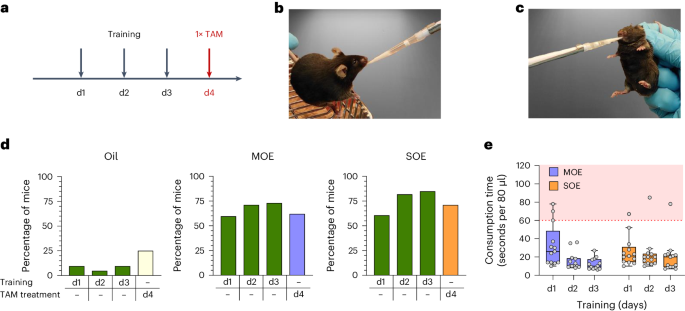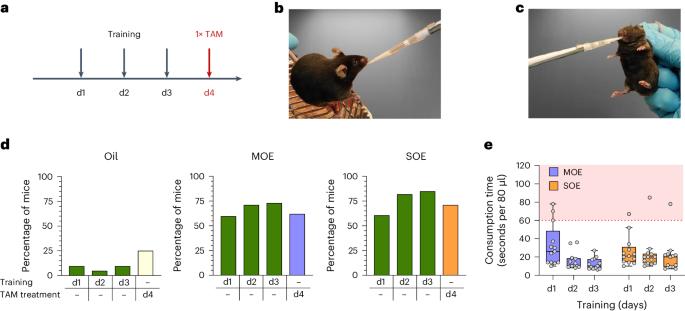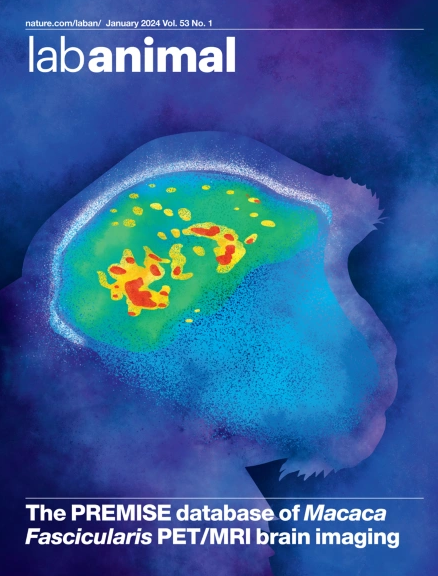通过鼓励小鼠自愿食用适口制剂来改进他莫昔芬的给药方法
IF 5.9
3区 农林科学
Q1 VETERINARY SCIENCES
引用次数: 0
摘要
在临床前啮齿动物模型中给药对于研究和开发新型疗法至关重要。目前已经开发出了一些体贴的给药方法,但这些方法大多与他莫昔芬等水不溶性药物不兼容,或者无法精确掌握给药时间或剂量。二十多年来,人们通过给 CreERT2-loxP 基因修饰小鼠模型口服或注射他莫昔芬来控制基因表达的时空,近年来这种可诱导模型的数量稳步增加。因此,准确施用他莫昔芬或其他水不溶性药物的动物友好型程序将对动物福利产生重要影响。在之前公布的微量移液管喂药方案的基础上,我们开发了适口的制剂,以鼓励动物自愿服用他莫昔芬。我们评估了小鼠在训练和治疗过程中对新配方的接受程度,并评估了他莫昔芬介导的 CreERT2-loxP 依赖性报告基因的诱导效果。甜牛奶和糖浆制剂都能鼓励小鼠自愿服用他莫昔芬,但在诱导CreERT2-介导的基因表达方面,只有甜牛奶制剂在统计学上不优于口服灌胃或腹腔注射。使用内部开发的细胞测定法对血清中他莫昔芬代谢物的浓度进行量化,结果证实糖浆制剂的疗效低于甜牛奶制剂。我们发现用微量移液管给药比口服或注射更准确,而且这种方法对实验者的培训要求不高。与口服给药或注射给药相比,新的适口溶液可鼓励患者自愿服用他莫昔芬而不会降低药效,因此是一种经过改进的给药方法。本文章由计算机程序翻译,如有差异,请以英文原文为准。


Refined tamoxifen administration in mice by encouraging voluntary consumption of palatable formulations
Drug administration in preclinical rodent models is essential for research and the development of novel therapies. Compassionate administration methods have been developed, but these are mostly incompatible with water-insoluble drugs such as tamoxifen or do not allow for precise timing or dosing of the drugs. For more than two decades, tamoxifen has been administered by oral gavage or injection to CreERT2–loxP gene-modified mouse models to spatiotemporally control gene expression, with the numbers of such inducible models steadily increasing in recent years. Animal-friendly procedures for accurately administering tamoxifen or other water-insoluble drugs would, therefore, have an important impact on animal welfare. On the basis of a previously published micropipette feeding protocol, we developed palatable formulations to encourage voluntary consumption of tamoxifen. We evaluated the acceptance of the new formulations by mice during training and treatment and assessed the efficacy of tamoxifen-mediated induction of CreERT2–loxP-dependent reporter genes. Both sweetened milk and syrup-based formulations encouraged mice to consume tamoxifen voluntarily, but only sweetened milk formulations were statistically noninferior to oral gavage or intraperitoneal injections in inducing CreERT2-mediated gene expression. Serum concentrations of tamoxifen metabolites, quantified using an in-house-developed cell assay, confirmed the lower efficacy of syrup- as compared to sweetened milk-based formulations. We found dosing with a micropipette to be more accurate than oral gavage or injection, with the added advantage that the method requires little training for the experimenter. The new palatable solutions encourage voluntary consumption of tamoxifen without loss of efficacy compared to oral gavage or injections and thus represent a refined administration method. Pairing palatable formulations with micropipette dosing for administration of water-insoluble drugs such as tamoxifen in mice promotes voluntary consumption without loss of efficacy compared to more invasive administration methods.
求助全文
通过发布文献求助,成功后即可免费获取论文全文。
去求助
来源期刊

Lab Animal
农林科学-兽医学
CiteScore
0.60
自引率
2.90%
发文量
181
审稿时长
>36 weeks
期刊介绍:
LabAnimal is a Nature Research journal dedicated to in vivo science and technology that improves our basic understanding and use of model organisms of human health and disease. In addition to basic research, methods and technologies, LabAnimal also covers important news, business and regulatory matters that impact the development and application of model organisms for preclinical research.
LabAnimal's focus is on innovative in vivo methods, research and technology covering a wide range of model organisms. Our broad scope ensures that the work we publish reaches the widest possible audience. LabAnimal provides a rigorous and fair peer review of manuscripts, high standards for copyediting and production, and efficient publication.
 求助内容:
求助内容: 应助结果提醒方式:
应助结果提醒方式:


